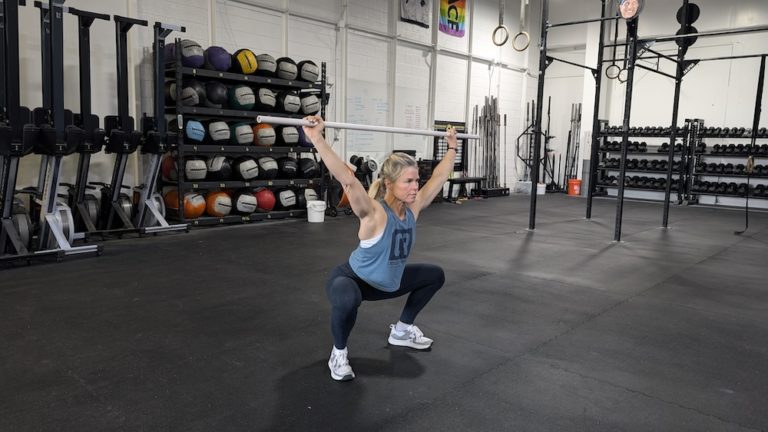Question: My wrists hurt during front and overhead squats. What should I do?
If you have been coaching for any period, you have likely received a question or complaint about wrist pain in the front and/or the overhead squat. This is a question that I expect new athletes to ask. I have gravitated toward pre-empting this question during my initial instruction by letting them know they may feel some discomfort in the wrists, that it is a normal part of the learning process, and to let me know when/if they start feeling discomfort. Here is information to keep in mind when asked about this issue.
Wrist Pain in the Front Squat
When experiencing wrist pain during the front squat, the natural assumption many athletes have is that they lack flexibility in their wrists. This is an understandable assumption as that is where the pain is occurring. However, wrist flexibility is likely not the root cause of the issue. If the athlete can perform a push-up where the entire hand remains on the floor throughout the full range of motion, they likely have adequate wrist flexibility.
In the front squat, the wrists are likely being compromised due to a lack of flexibility in the shoulders, lats, and/or triceps. The best way to improve this position is by replicating the position and, in this instance, holding the bar in the front-rack position while trying as best as possible to drive the elbows toward the ceiling. This is often not the response that athletes want to hear, but it’s the honest answer. There is no harm in doing a specific range of motion drill like this band front-rack mobilization before a front squat or clean workout.

You can also assess if your athlete’s torso position in the front squat is the cause of the wrist pain. If your athlete has an immature squat, where the torso leans excessively forward, the wrists may be compromised. In this instance, striving for a more upright torso position in the squat will be most advantageous through consistent effort and practice. Improving ankle range of motion could aid with a more upright torso and a squatting drill like a counter-balance squat.
Proper hand positioning and rack-position mechanics can also aid with wrist pain. There is a common tendency for athletes to want to maintain a tight and full grip on the bar while attempting to reach their elbows upward. In this instance, we can teach our athletes to open their hands and allow the bar to roll toward their fingertips while reaching their elbows upward. Although not ideal, the athlete can release one or two fingers from the bar if needed. A relaxed grip will aid many athletes by allowing the bar to rest on their shoulders in a sound front-rack position.
In VERY RARE instances, we can adopt a new rack position or utilize dumbbells. These modifications can be adopted for those with severe pain or if there is a risk of their elbows colliding with their knees in the bottom position.
Wrist Pain in the Overhead Squat
Wrist pain in the overhead squat can also be an issue for many athletes. If an athlete is new to this movement, it will be natural for the wrists to take some time to develop the strength to bear loads in this position.
You can narrow your athlete’s grip width to alleviate pain. The pain in the wrist is typically caused by the awkward position of the wrists with a very wide grip. A narrower grip can be used for a period while the athlete builds strength in the region and progresses to a wider grip over time. Be mindful that a narrower grip will limit the range of motion about the shoulders, which could be an added issue for those with poor flexibility.
 If shoulder flexibility is an issue, the athlete must use a wide grip. The best remedy is to perform the movement in a slow and controlled manner with a very light load or PVC. Range of motion drills for the shoulders can also be included, with my personal favorite being bar hang with a narrow grip position.
If shoulder flexibility is an issue, the athlete must use a wide grip. The best remedy is to perform the movement in a slow and controlled manner with a very light load or PVC. Range of motion drills for the shoulders can also be included, with my personal favorite being bar hang with a narrow grip position.
Similar to the front squat, an immature squat can compromise wrist position. With an immature squat, the athlete will be forced to widen their hands to increase the range of motion about the shoulder to keep the bar in the frontal plane. In this instance, striving for a more vertical torso position will be the goal.
Most importantly, coach this movement with relentlessness, patience, and positivity. It’s difficult, but the rewards of developing it are worth it.
Have a question for a coach? Please submit that here.
About the Author
 Eric O’Connor is a Content Developer and Seminar Staff Flowmaster for CrossFit’s Education Department and the co-creator of the former CrossFit Competitor’s Course. He has led over 400 seminars and has more than a decade of experience coaching at a CrossFit affiliate. He is a Certified CrossFit Coach (CF-L4), a former Division 1 collegiate wrestler, and a former CrossFit Games athlete.
Eric O’Connor is a Content Developer and Seminar Staff Flowmaster for CrossFit’s Education Department and the co-creator of the former CrossFit Competitor’s Course. He has led over 400 seminars and has more than a decade of experience coaching at a CrossFit affiliate. He is a Certified CrossFit Coach (CF-L4), a former Division 1 collegiate wrestler, and a former CrossFit Games athlete.
Ask a Coach: My Wrists Hurt During Front and Overhead Squats. What Should I Do?